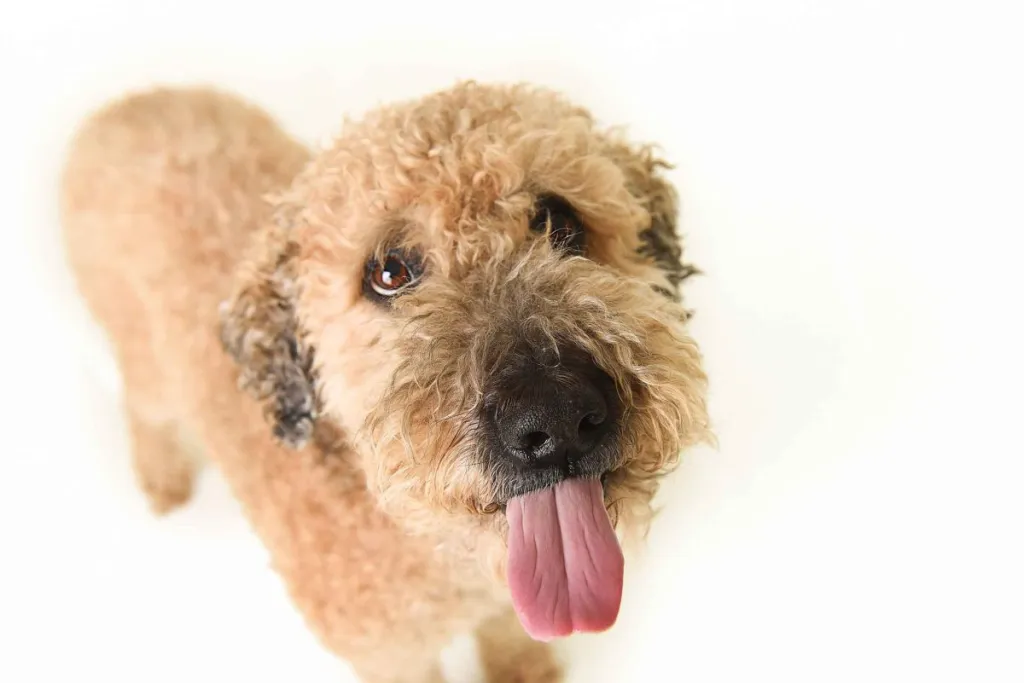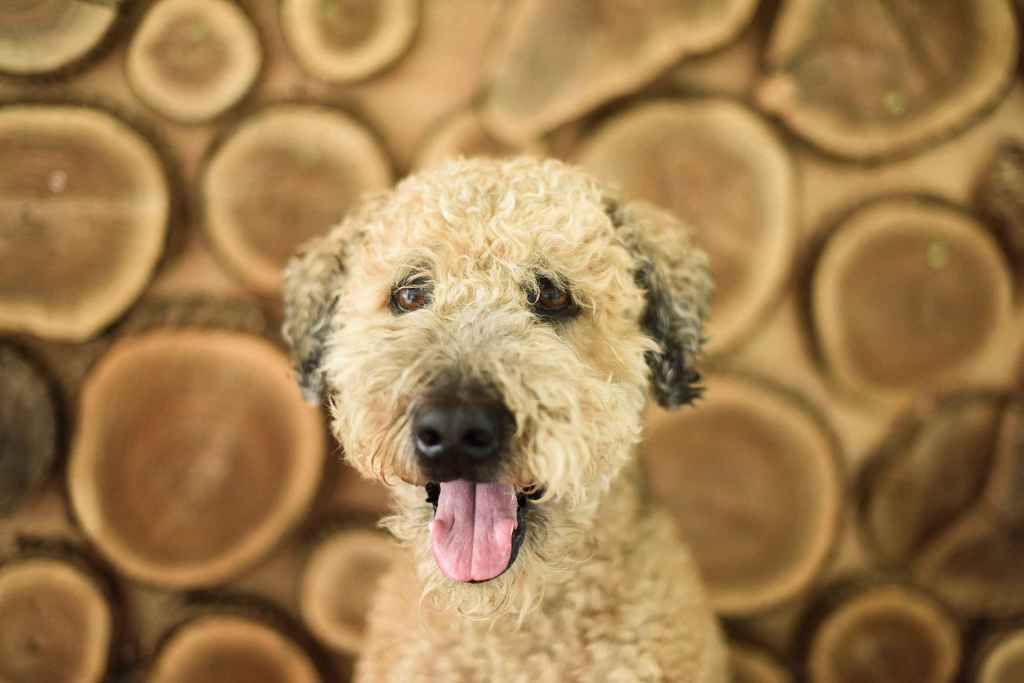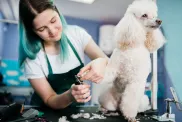The Whoodle is a medium-sized cross between the Soft-Coated Wheaten Terrier and Poodle dog breeds. Playful, friendly, and active, these Poodle mixes inherited some of the best qualities from both of their parents. Whoodles also go by the names the Wheatendoodle, the Wheatenpoo, the Sweatendoodle, and the Sweatenpoo. Despite their plush image, you may find these mixed-breed dogs in shelters and rescues, so remember to always adopt! Don’t shop!
These super cute canines make for smart and friendly dogs, and you’ll love showing off photos of your Whoodle to your family and friends. But Wheaten Terrier Poodle mixes are also extremely active dogs and can be very headstrong at times, so you’ll need to demonstrate that you’re in charge of the household when you bring your pup home.
Whoodle characteristics
- Height: 12 to 20 inches at the shoulder
- Weight: 20 to 45 pounds
- Lifespan: 12 to 15 years
Coat and color variations
The Whoodle has a coat that varies between wavy and curly textures, often leaning more toward the hypoallergenic, low-shedding qualities inherited from the Poodle. Their coat is usually soft, dense, and fluffy, requiring regular grooming to maintain its condition and prevent matting. Whoodles come in a range of colors, often including shades of apricot, black, cream, silver, or gray.
Some Whoodles may even have a mix of colors or a coat that changes in hue slightly as they age. Because both parent breeds contribute unique qualities, each Whoodle’s coat can vary in length, texture, and even color tone, with some appearing lighter or darker depending on the genes inherited.
Physical traits and appearance
- Size: Medium, typically standing 12–20 inches tall and weighing 20–45 pounds, depending on whether they have Miniature, Standard, or Toy Poodle ancestry.
- Body Shape: Compact and muscular, with a sturdy build that reflects the strength of the Wheaten Terrier parent.
- Face: Expressive, with almond-shaped eyes that give a warm and inquisitive look.Ears: Floppy and medium-length, often with a soft wave or curl.
- Nose: Typically black, though some may have brown noses depending on coat color.
- Tail: Curved or straight, often fluffy, and sometimes carried high or with a slight curl.
- Feet: Rounded and compact, with well-padded paws that give a sturdy stance.
How big does a Whoodle get?
A Whoodle typically grows to a medium size, with their height and weight depending on whether they inherit more from the Soft-Coated Wheaten Terrier or the Poodle parent. Generally, Whoodles stand between 12 to 20 inches tall at the shoulder and weigh between 20 to 45 pounds. The size can vary based on whether the Poodle parent was a Miniature, Toy, or Standard Poodle. Miniature Whoodles are usually on the smaller end of the scale, while Standard Whoodles tend to be larger.
Whoodle personality
The Whoodle is known for their friendly and outgoing personality. These dogs are typically affectionate and eager to please, forming strong bonds with their human companions. Their playful nature means they enjoy engaging in various activities, from fetch in the backyard to long walks around the neighborhood. Whoodles are intelligent and curious, which makes them not only fun to be around but also relatively easy to train. Their desire for mental stimulation means they thrive on learning new commands and tricks, making training sessions a rewarding experience for both dog and owner.
Whoodles are also social animals that usually get along well with children and other pets. Their gentle demeanor and playful spirit make them great playmates for kids, while their adaptable nature allows them to fit into multi-pet households. However, because of their strong need for companionship, Whoodles may experience separation anxiety if left alone for long periods.
Temperament and behavior
- Affectionate and Loyal: Forms strong bonds with family members and enjoys physical affection.
- Playful and Energetic: Loves interactive play and outdoor activities, requiring regular exercise to stay happy.
- Intelligent and Trainable: Quick learners who respond well to positive reinforcement, thriving on mental stimulation.
- Social and Friendly: Generally gets along well with children and other pets, enjoying social interactions.
- Adaptable: Can adjust to various living situations, from apartments to larger homes, as long as they receive attention and exercise.
- Sensitive to Alone Time: Prone to separation anxiety if left alone for extended periods; thrives in a home where someone is often present.

Training and socialization
Early socialization and positive reinforcement training are crucial due to their intelligence and potential stubbornness. Of course, their intelligence allows them to pick up commands quickly, so early training is key to establishing good behavior from the start. Use praise, treats, and affection to reward desired behavior. Whoodles respond well to positive reinforcement, and this approach will keep them motivated and engaged.
Training tips:
- Be Consistent: Consistency is crucial in training. Use the same commands and routines to avoid confusion. This helps your Borderdoodle understand what is expected of them.
- Keep Training Sessions Short and Fun: Whoodles are intelligent but can lose interest if training sessions are too long or repetitive. Keep sessions short (10-15 minutes) and engage with varied activities.
- Mental Stimulation: Incorporate puzzle toys, obedience training, and interactive games into their routine to challenge their mind. A bored Whoodle can become restless or destructive. Once basic obedience is established, teach more advanced commands or tricks. Their intelligence makes them excellent candidates for agility training, fetch, or scent games.
Whoodle care
Caring for a Whoodle involves meeting their physical, emotional, and social needs to ensure they thrive as happy, healthy companions. As a playful and energetic breed, Whoodles require regular exercise, which can include daily walks, playtime, or interactive activities to keep them engaged. Their social nature means they thrive on companionship and interaction, making them well-suited for families or individuals who can spend quality time with them.
Whoodle grooming needs
Grooming a Whoodle is a vital part of their care routine, as they have a soft, curly coat that is prone to matting without proper maintenance. Their coat requires regular brushing to prevent tangles and mats, with a grooming schedule that typically includes brushing several times a week. Bathing should occur every month or as needed, using a gentle, dog-friendly shampoo to keep their coat clean and healthy. In addition to regular grooming, Whoodles also need their ears checked for cleanliness, nails trimmed, and teeth brushed to ensure good overall health.
How to groom a Whoodle
Coat care
- Brushing: Brush the coat 3–4 times per week with a slicker brush or comb to prevent matting and tangling, focusing on areas like the ears, armpits, and behind the legs.
- Bathing: Bathe your Whoodle every 4–6 weeks or as needed, using a mild dog shampoo that suits their coat type, and ensure to rinse thoroughly to avoid residue.
- Trimming: Schedule professional grooming every 4–6 weeks for a trim to maintain coat length and shape, particularly around the face, feet, and tail.
Ears, nails, and teeth
- Ears: Check and clean ears weekly with a vet-recommended cleaner to remove wax buildup and prevent infections, especially given their floppy ears.
- Nail Trimming: Trim nails every 3–4 weeks to keep them short and healthy; consider using a nail grinder for a smoother finish.
- Teeth Brushing: Brush their teeth 2–3 times a week using dog-specific toothpaste to prevent dental issues and maintain good oral hygiene.
Check for skin issues
- Inspect Regularly: As you groom, check their skin for any signs of irritation, redness, or bumps. If you notice anything unusual, consult a vet.
Flea, tick, and parasite control
- Keep up with flea and tick prevention treatments, especially if your Borderdoodle spends much time outdoors. Regular grooming allows you to spot parasites early.
Early acclimation is key
Getting your Whoodle accustomed to grooming procedures from a young age makes the process easier and more enjoyable for both of you. Handle their paws frequently, examine their mouth and ears, and reward them for good behavior during grooming sessions. This positive foundation sets the stage for stress-free veterinary exams and handling throughout their lives.
Whoodle feeding and nutrition
Feeding and nutrition for a Whoodle is crucial for their overall health and well-being. As with all dogs, the Whoodle’s dietary needs will change from puppyhood to adulthood and will continue to change into their senior years. You should ask your veterinarian for recommendations about your Whoodle’s diet, as there is far too much variation among individual dogs–including weight, energy, and health–to make a specific recommendation.
Quality Dog Food:
- Choose a high-quality dog food formulated for small to medium breeds. Look for options that list real meat (like chicken, beef, or fish) as the first ingredient, ensuring the food provides adequate protein.
- Consider a balanced diet that includes healthy fats, carbohydrates, vitamins, and minerals to support their active lifestyle.
Portion Sizes:
- The typical daily food intake for a Whoodle ranges from 1 to 2 cups of dry kibble, depending on their size, age, activity level, and metabolism.
- It’s best to split their daily portion into two meals to help prevent overeating and digestive issues.

Whoodle and family compatibility
Whoodles are exceptionally compatible with families, thanks to their friendly, affectionate, and adaptable nature. They thrive on companionship and love being part of family activities, making them wonderful playmates for children. Their gentle demeanor means they usually handle the hustle and bustle of family life well, and they often enjoy interactive play, such as fetch, hide-and-seek, or simply running around the yard. Because Whoodles are known for their sociable personality, they typically get along well with other pets, including dogs and cats, particularly when they have been properly socialized from a young age.
Whoodle health issues
Whoodles are generally considered to be healthy dogs, although they can suffer from some common health issues. As with any dog, it’s important to maintain good care and schedule regular veterinary checkups. Some of the more common health problems Whoodles suffer from include:
- Eye infections and diseases: Refers to a range of conditions affecting the eyes, including conjunctivitis, keratitis, glaucoma, and cataracts. Symptoms may include redness, discharge, cloudiness, or vision changes, and treatment varies depending on the specific condition.
- Kidney issues: These include various kidney diseases such as kidney stones, renal failure, and urinary tract infections. Symptoms may include increased thirst, frequent urination, lethargy, and loss of appetite. Treatment often involves medication, dietary changes, and in severe cases, dialysis or kidney transplantation.
- Addison’s disease: Also known as hypoadrenocorticism, Addison’s disease is a hormonal disorder that occurs when the adrenal glands fail to produce enough cortisol and aldosterone. Symptoms include lethargy, weakness, vomiting, diarrhea, and weight loss. Treatment typically involves lifelong hormone replacement therapy to manage symptoms and maintain quality of life.
- Retinal atrophy: Refers to the degeneration of the retina, the light-sensitive tissue lining the back of the eye.
Whoodle rescue groups
It may be hard to find a breed-specific rescue for Whoodles because they are a mixed breed. However, you may want to try Soft-Coated Wheaten Terrier or Poodle breed-specific rescues, as they often care for mixes, as well. Here are some rescues you can try:











